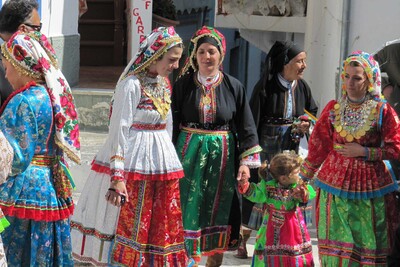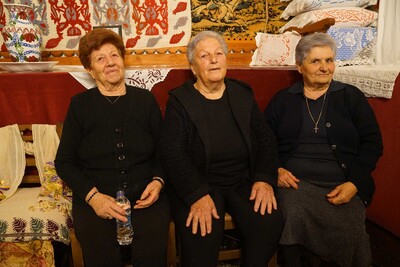
Dodecanese Greek
Glottocode: dode1238
The Southeast Greek islands have a couple of common linguistic features. As most of them belong to the Dodecanese archipelago, we call this dialect Dodecanese or Southeast Greek, even if some of the islands do not belong to the archipelago. The varieties spoken on the Dodecanese islands (Agathonisi, Astypalaia, Chalki, Kalymnos, Karpathos, Kasos, Kastellorizo. Kos, Leipsoi, Leros, Nisyros, Patmos, Rhodes, Symi, and Tilos) have many similarities with the islands of Chios and Ikaria so that we treat them here as one group. Especially in Rhodes, there is some written dialectal evidence (mainly poems) since the 14th century. Although showing certain common trends, the Dodecanese idioms are characterized by the huge variety and often differentiation from island to island or even between different regions of the same island (especially Rhodes and Karpathos). Dodecanese Greek shows remarkable similarities with the Cypriot and Cretan dialects, as well as with other idioms of nearby islands and some of the Cyclades. At this point, the field recordings by Thede Kahl and Sotirios Rousiakis (2016-2023) from Rhodes, Karpathos, Symi, and Ikaria will be successively presented and published.
Settlements represented in our collection
Description of Dodecanese Greek
The main characteristics of the Dodecanese Greek idioms are as follows:
Phonetics-Phonology
- silencing of [v], [c], and [ð] between vowels: well [piáði], iron [síero], sheep [prōato], traɣuðúsi > trauðúsi “they sing”
- The clusters [rθ], [rγ], [vγ] are replaced by [rt], [rk], [vk], e.g.: I came [írta], tower [pírkos], eggs [avká].
- The final [n] is retained and is often assimilated to the following consonant: xylon [ksílon], kartín [xartín], mián volán > miav-volán “one time”, lao [tol laόn]; the result of assimilation is the presence of secondary double consonants.
- Double consonants (l, m, n, s, ð, v, χ, θ, f) are pronounced as such, and this pronunciation sometimes extends to words in which they do not occur as double consonants. Other times the silent double consonants (kk, pp, tt) are pronounced as [kx] [pf] [tθ], e.g. lacchos (lacchus), papfu (pappos).
- The stops k, p, t are pronounced kh ph th.
- In some areas, tsitakism occurs, i.e. /k/ is pronounced [t∫] before [i] and [e]: and [t∫e]. In Kos, Astypalaia, North Rhodes, Karpathos, Kalymnos, and Nisyros the k before e, i is pronounced ʦ. In Patmos ʨ. In south Chios the k before e, I, ĭ becomes ʦ, ʨ. : ʦe “and”, kóʦino “red” ʦerí “candle”. And the g before e, I, ĭ is pronounced ʣ. ánʣira “anchor”.
- The semi-phoneme ʝ is run into [s] or [∫] (thick s) after a voiceless consonant and into [ʒ] (thick z) after a resonant one, e.g. pσ'άνω (to catch), σέρζ'α (hands).
- On Ikaria, the sequence s, z +ĭ+V changes into s, z +V. : nisá “islands”, krasá “vines”.
Morphology
- The endings -ousi(n) and -asi(n) in the third person plural present and imperfect tense respectively: rabousi, steal, sell, rávɣusi “they swee”, pulúsin “they sell”, χtísasi “they built”, k'endísasi “they embroidered”
- The verbal endings -εύκω and -εύγγω instead of -εύω are used: δουλέβκω /δουλέβɟω (δουλεύω)
- The syllabic augmentation is retained even if atonal, while syllabic augmentation h- [i] is often found: ηπηρα, ήκουσα, ηφέρνανε, ηποφασισανε.
- Finally, the Dodecanese idioms belong, according to Kontosopoulos (2000, 44), to the zone ofείντα 'τί'.
- In many regions, the personal pronouns follow the verb: ípen tu “he says to him”, efχaristó su “I thank you”.
- On most islands the word for "yes" is iné, inné and the word for what" is índa.
Contemporary sociolinguistic situation
As Kontosopoulos (2000) points out, the Dodecanese idioms show a strong tendency to decline due to the prevalence of the Modern Greek common and migration to the large urban centers of the country. Zachariou-Mamaliga (1994: 94) makes similar observations, especially concerning the idiom of Symi, noting that, after the liberation of the Dodecanese from the Italians (1945) and their incorporation into the Greek state (1948), easier communication and stronger contacts with the central Greek regions imply the strong influence of the Modern Greek common in the speech of the inhabitants of this island. Kahl and Rousiakis However, as is the case with most Greek dialects and idioms, modern records and analyses of Dodecanese speech are lacking, so one cannot speak with certainty about the existence or otherwise of dialectal elements and which ones. The individual studies that have been carried out are mostly collections of dialectal material with the aim of 'rescuing' it and have been carried out with an older methodology (i.e. mainly through the recording of 'particular' pronunciation and 'deviant' vocabulary) and concern certain phenomena or idioms in isolation rather than a comprehensive and systematic approach to Dodecanese idioms (cf. among others Charalambidou 1972 Kardiolaka 1992 Vagiakos 1994 Zachariou-Mamaliga 1994 Henrich 1994 Katsouleas 1994 Papamanoli 1994 Minas 2004).
©
Bibliography
- Henrich, Günther S. (1994): Ροδίτικα φωνητικά φαινόμενα σε 3 ποιήματα του Μανόλη Λιμενίτη. Νεοελληνική διαλεκτολογία. Πρακτικά 1ου Πανελλήνιου Συνεδρίου Νεοελληνικής Διαλεκτολογίας (Ρόδος 26-30/3/1992), 1: 131-141. Αθήνα.
- Thumb, Albert (1893, 1897): Der Dialekt von Amorgos. Indogermanische Forschungen, Beiträge zur neugriechischen Dialektkunde 2: 64-25; 7: 1-37.
- Βαγιάκος, Δ. Β. (1994): Κοινά διαλεκτικά Δωδεκανήσου και Μάνης. Νεοελληνική διαλεκτολογία. Πρακτικά 1ου Πανελλήνιου Συνεδρίου Νεοελληνικής Διαλεκτολογίας (Ρόδος 26-30/3/1992) 1: 43-63, Αθήνα.
- Ζαχαρίου-Μαμαλίγκα, Ελένη (1994): Η σημερινή κατάσταση του συμαϊκού ιδιώματος. Νεοελληνική διαλεκτολογία. Πρακτικά 1ου Πανελλήνιου Συνεδρίου Νεοελληνικής Διαλεκτολογίας (Ρόδος 26-30/3/1992), 1: 94-115, Αθήνα.
- Καρδιολάκα, Βασιλική (1992): Η δάσυνση των συμφώνων p-t-k στο ιδίωμα τα Καλύμνου σε σύγκριση με το αντίστοιχο φαινόμενο στα τσακώνικα. Στο Μελέτες για την Ελληνική Γλώσσα. Πρακτικά της 13ης ετήσιας συνάντησης του Τομέα Γλωσσολογίας του Τμήματος Φιλολογίας της Φιλοσοφικής Σχολής του Αριστοτελείου Πανεπιστημίου Θεσσαλονίκης, 7-9 Μαΐου 1992, 163-177, Θεσσαλονίκη.
- Κατσουλέας, Σ. Γ. 1994. Το τελικό ν και η δίπλωση των συμφώνων στο ιδίωμα του Καστελλορίζου. Στο Νεοελληνική διαλεκτολογία. Πρακτικά 1ου Πανελλήνιου Συνεδρίου Νεοελληνικής Διαλεκτολογίας (Ρόδος 26-30/3/1992), 1: 203-227, Αθήνα.
- Μηνάς, Κωνσταντίνος Μ. (1970): Τα ιδιώματα της Καρπάθου. Αθήνα.
- Μιχαηλίδης-Νουάρος, Μ. (1972): Λεξικόν της καρπαθιακής διαλέκτου. Καρπαθιακά μνημεία
- Παντελίδης, Νικόλαος (2016): Μία νοτιοελλαδική διαλεκτική ζώνη. Μελέτες για την Ελληνική Γλώσσα, 303-313.
- Παπαμανώλη, Λούλα (1994): Γλωσσοπλαστικές ευαισθησίες του Ροδίτικου λαού. Νεοελληνική διαλεκτολογία. Πρακτικά 1ου Πανελλήνιου Συνεδρίου Νεοελληνικής Διαλεκτολογίας (Ρόδος 26-30/3/1992), 1: 371-434, Αθήνα.
- Τσοπανάκης, Αγαπητός (1949): Το ιδίωμα της Χάλκης (Δωδεκανήσου). Ρόδος.
- Χαβιαράς, Δημοσθένης (1891): Συμαϊκά. Ζωγράφειος Αγών Α, 211-265.

